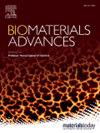基于聚(三亚甲基碳酸酯-co-ε-己内酯)和重组类人胶原蛋白的多孔光交联杂交网络。
IF 5.5
2区 医学
Q2 MATERIALS SCIENCE, BIOMATERIALS
Materials Science & Engineering C-Materials for Biological Applications
Pub Date : 2024-11-04
DOI:10.1016/j.bioadv.2024.214106
引用次数: 0
摘要
用重组类人胶原蛋白(rh-collagen)和聚(碳酸三亚甲基酯-co-ε-己内酯)(P(TMC-co-ε-CL))制备了混合水凝胶网络,以克服各自网络在机械和生物活性方面的局限性。这两种聚合物都用甲基丙烯酸酐进行了官能化处理,生成了光交联材料。在酸化的二甲基亚砜(DMSO)中对功能化聚合物溶液的冷冻混合物进行光交联,制备出不同成分的多孔杂化网络。用水萃取后,得到的网络具有预期的成分、高孔隙率和凝胶含量。在水中平衡后,发现总含水量随着胶原蛋白含量的增加而增加。与 rh 胶原网络相比,混合网络的拉伸性能和缝合保持强度(SRS)都有所提高。特别是 17:83 wt% rh-collagen:P(TMC-co-ε-CL) 网络具有更高的韧性和 SRS,显示出作为一种杂交水凝胶网络的前景,有望进一步用于组织工程研究。本文章由计算机程序翻译,如有差异,请以英文原文为准。
Porous photo-crosslinked hybrid networks based on poly(trimethylene carbonate-co-ε-caprolactone) and recombinant human-like collagen
Hybrid hydrogel networks were prepared from recombinant human-like collagen (rh-collagen) and poly(trimethylene carbonate-co-ε-caprolactone) (P (TMC-co-ε-CL)) to overcome the mechanical and bioactivity limitations associated with the respective individual networks. Both polymers were functionalised with methacrylic anhydride to yield photo-crosslinkable materials. Porous hybrid networks of different compositions were prepared by photo-crosslinking frozen mixtures of solutions of the functionalized polymers in acidified DMSO. After extraction with water, the obtained networks had the intended compositions, high porosities and gel content. Upon equilibration in water, the total water content was found to increase with increasing collagen content. The tensile properties and suture retention strength (SRS) of the hybrids were improved compared to a rh-collagen network. In particular, the 17:83 wt% rh-collagen:P(TMC-co-ε-CL) network had considerably higher toughness and SRS, showing promise as a hybrid hydrogel network to be further investigated for tissue engineering purposes.
求助全文
通过发布文献求助,成功后即可免费获取论文全文。
去求助
来源期刊
CiteScore
17.80
自引率
0.00%
发文量
501
审稿时长
27 days
期刊介绍:
Biomaterials Advances, previously known as Materials Science and Engineering: C-Materials for Biological Applications (P-ISSN: 0928-4931, E-ISSN: 1873-0191). Includes topics at the interface of the biomedical sciences and materials engineering. These topics include:
• Bioinspired and biomimetic materials for medical applications
• Materials of biological origin for medical applications
• Materials for "active" medical applications
• Self-assembling and self-healing materials for medical applications
• "Smart" (i.e., stimulus-response) materials for medical applications
• Ceramic, metallic, polymeric, and composite materials for medical applications
• Materials for in vivo sensing
• Materials for in vivo imaging
• Materials for delivery of pharmacologic agents and vaccines
• Novel approaches for characterizing and modeling materials for medical applications
Manuscripts on biological topics without a materials science component, or manuscripts on materials science without biological applications, will not be considered for publication in Materials Science and Engineering C. New submissions are first assessed for language, scope and originality (plagiarism check) and can be desk rejected before review if they need English language improvements, are out of scope or present excessive duplication with published sources.
Biomaterials Advances sits within Elsevier''s biomaterials science portfolio alongside Biomaterials, Materials Today Bio and Biomaterials and Biosystems. As part of the broader Materials Today family, Biomaterials Advances offers authors rigorous peer review, rapid decisions, and high visibility. We look forward to receiving your submissions!

 求助内容:
求助内容: 应助结果提醒方式:
应助结果提醒方式:


